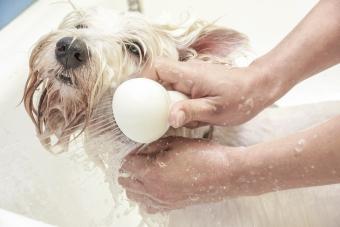
It's a fact of life that puppies, and that dogs in general, can be messy. There are quite a few substances that can stain your dog's fur, but when it's urine, this tends to make people quite uncomfortable. Plus, it's a dog owner's job to keep their dog's personal hygiene in check and see to their well-being.
Urine Stains Fur
For urine to stain your dog's fur, it has to be allowed to set in. This means the urine must have been there for quite some time, especially if the dog's fur is now stained rather than being able to simply wash the yellow color out. If the stains are primarily on the back legs, this indicates the puppy or dog has been sitting in urine rather than being urinated on.
There are shampoos that will help lighten urine stains. You can also try one of the products made to combat tear stains to see if it removes the yellowing more quickly. The good news is, once you get the staining out, simple routine bathing will keep your dog looking good.

Removing the Urine Stain from Your Dog's Fur
How quickly the stains and smells come out depends on the type of coat the puppy has. A short-coated puppy will shed out the stained fur as its adult coat comes in. A long-coated puppy will retain the staining longer, but it can be trimmed away as the coat lengthens.
To reduce the amount of time it takes the stain to come out, and ensure your dog looks and feels clean, there are several steps you can take at home to help.
Step One
Brush your dog thoroughly and focus on the stained area. This will remove dead hair and loose debris you may find in your dog's fur. By removing the dead fur and debris, the shampoo will be able to soak further into the coat. Be certain to use the right brush for your dog's coat. The wrong brush can do more harm than good and your dog could end up with an unhealthy, and still stained, coat.
Step Two
Gently scrub the stained area with a warm, damp washcloth. Alternatively, you can use a few pet grooming wipes from the pet store. Mix in a bit of dry shampoo before moving to step three.
Step Three
It's now time to give your dog a bath. Don't forget to purchase shampoo specifically formulated for your dog's coat type and color. For example, dogs who are purely white have shampoos specifically formulated for their coat color. Their shampoos include a type of coloring agent that neutralizes the stains within their coat and aids them in leaving the bath clean and looking spot-free.

Step Four
If the above steps did not work, it might be time to consult with a professional groomer. Professional groomers have a host of tools at their disposal, as well as the knowledge necessary to remove stains safely. If you're concerned about the products the groomer will use, simply ask them what type of products they utilize regularly within their clinic. A good groomer won't mind being transparent.
Take Risks into Consideration
There are risks to removing a urine stain yourself without consulting a grooming professional. It's important to take these risks into consideration prior to beginning the step-by-step process on your own. The risks and tips associated with each include:
- Be sure to read the ingredients on the label prior to purchasing a product. Many stain removal products can cause irritated skin and allergic reactions. If you're unsure about an ingredient, do some research before purchasing the product to determine exactly what it contains.
- Keep the cleaning product away from your dog's ears, mouth, and eyes. Even natural cleaning products can cause irritation if they get into the wrong places.
- Never mix homemade and commercial remedies together. The ingredients could interact with one another, resulting in a harmful concoction. If your trusted groomer does this, there is a strong possibility they have the education and experience to do so safely. That doesn't mean you should try it at home.
- If you notice your dog's skin drying, or if your dog is prone to dry skin, utilize a moisturizing product. A moisturizer will help keep your dog's skin healthy which is equally as important as their coat health.
- Bring your dog to the veterinarian if you notice any side effects following a cleaning. For example, if your dog's skin was irritated by a product, the skin may begin as red and inflamed, but quickly progress to a hotspot without treatment.
Regular Grooming is Key
Regular grooming to distribute oils and remove debris is critical in not only preventing stains but ensuring your dog's skin and coat remain healthy. Brush and bathe regularly, and spot clean between baths to prevent staining from occurring. When using grooming products, watch for any adverse interactions with your dog's skin. If you begin to notice irritation, don't hesitate to call your veterinarian and ask what steps you can take to clear it up.







